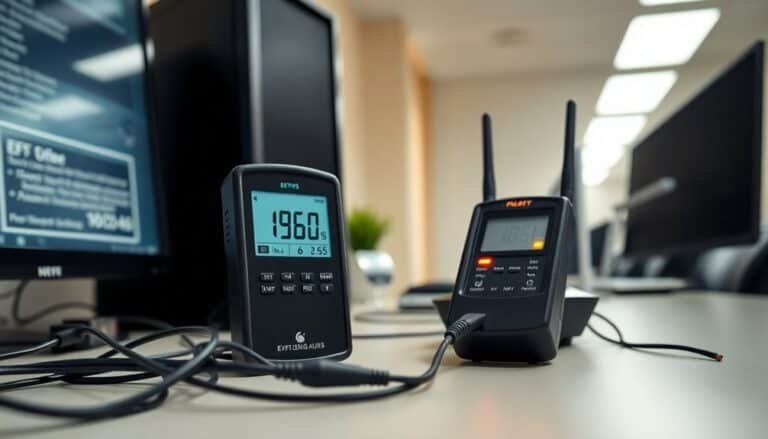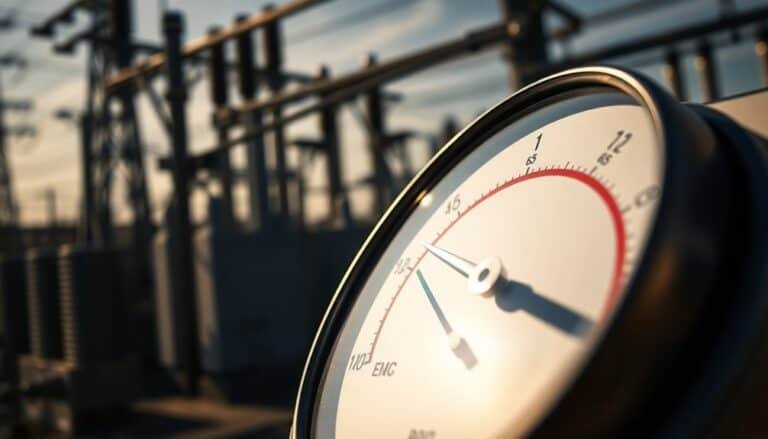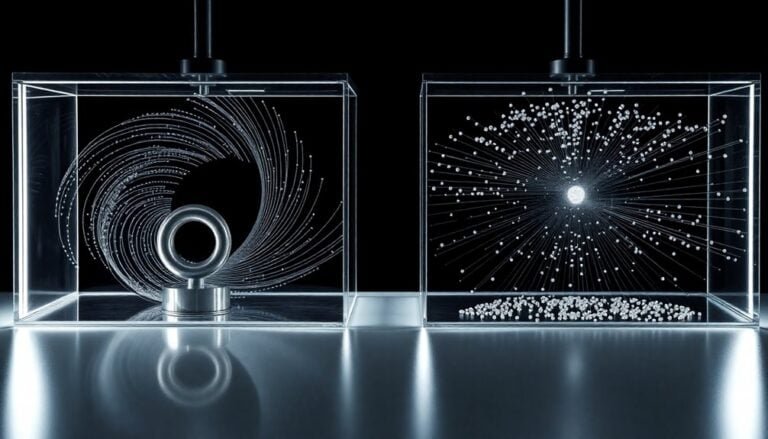Common Mistakes in Measuring EMF
When measuring EMF, be mindful of common errors like incorrect device placement and insufficient calibration, which can lead to distorted and unreliable data. Environmental factors such as background EMF and reflective surfaces, along with operator errors due to inadequate training, can also skew results.
To ensure accurate measurements, test shielding effectiveness thoroughly and consider all EMF sources. By understanding these factors, you can uncover nuances that enhance your approach.
Disclaimer: As an affiliate, I may collect a share of sales from the links on this page.
Incorrect Placement of Measurement Devices
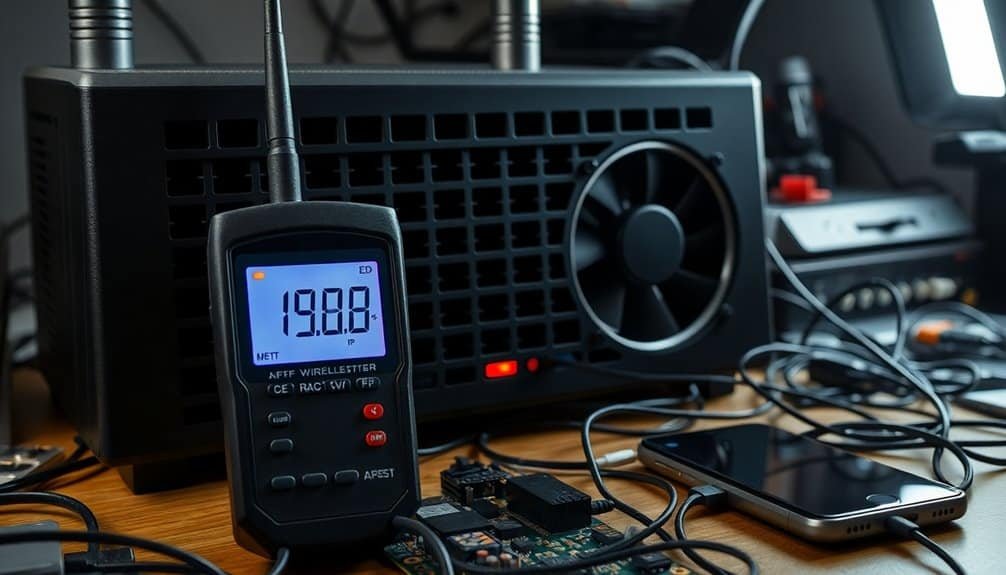
When measuring electromagnetic fields (EMF), incorrect placement of measurement devices can lead to significant inaccuracies. Physical obstructions, like furniture, interfere with readings, while nearby metallic objects distort the field. Additionally, any movement during measurement can result in erroneous data, especially for low-frequency waves. Common errors in measurement can exacerbate these issues and compromise results. Environmental factors, such as temperature and humidity, further complicate accuracy. Non-uniform field distribution requires precise positioning to capture accurate readings. Operators must guarantee ideal sensor orientation, avoiding dynamic environments where metal objects may move. To ensure effective readings, it is crucial to understand safe ELF levels for different types of electromagnetic fields.
Insufficient Calibration of Instruments
Insufficient calibration of instruments can critically undermine the accuracy of electromagnetic field (EMF) measurements. Calibration verifies that an instrument’s output aligns with known inputs, guaranteeing reliable readings.
Without proper calibration, you risk misinterpreting safety levels due to inaccurate data. Common errors include incorrect zeroing and sensitivity drift, which can diminish accuracy. Following manufacturer guidelines and industry standards is essential for consistency.
Neglecting scheduled calibration or relying on untrained personnel can exacerbate these issues. Consequently, implementing regular calibration practices, controlled environments, and detailed documentation is necessary to maintain data integrity and guarantee compliance with regulatory standards. Modern devices may only need calibration intervals of 10+ years, reducing the frequency of calibration checks compared to older models.
Failure to Consider Environmental Factors
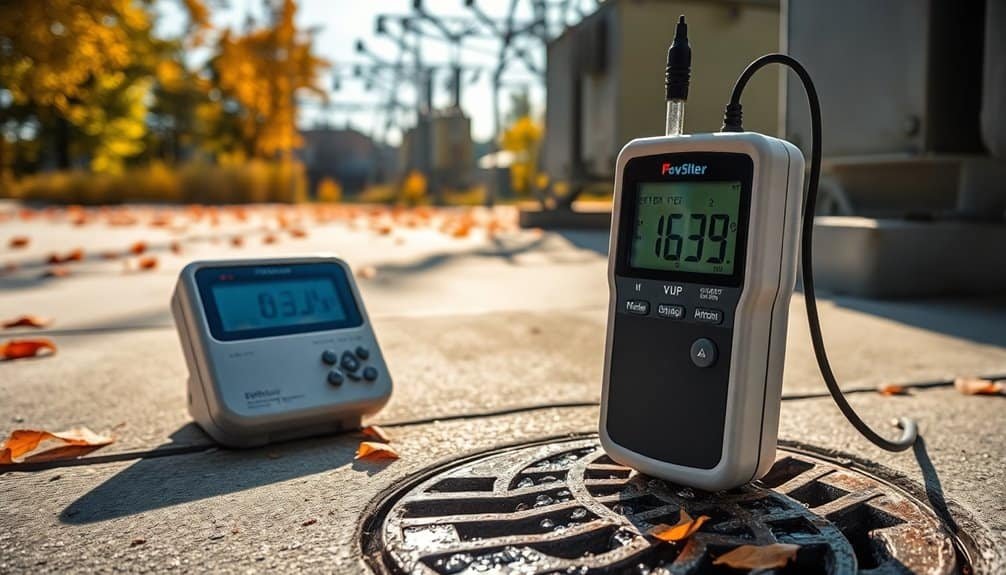
Neglecting environmental factors can greatly distort electromagnetic field (EMF) measurements. When measuring EMFs, it’s essential to take into account specific elements to guarantee accuracy:
- Background EMF Levels: Always account for existing EMF levels to avoid skewed results. This includes understanding that power lines can emit EMF radiation up to 1000ft, which may contribute to background levels.
- Proximity to Sources: Measure distances from potential EMF sources, like antennas, since this impacts readings considerably. For instance, magnetic field strength diminishes with distance from the source, which is crucial to consider during measurements.
- Multipath Effects: Reflective surfaces can alter the measured intensities, so take into account how the environment influences EMF paths. This is especially relevant when considering that power lines can significantly impact local EMF levels.
Failing to integrate these factors can lead to inaccurate assessments. Always prioritize these considerations to enhance the validity of your EMF measurements in any environment.
Inadequate Testing of Shielding Effectiveness
Inadequate testing of shielding effectiveness can produce misleading results, impacting both the reliability and applicability of your findings.
Variability in chamber setups often leads to inaccurate measurements. If you don’t control temperature and humidity, the shielding materials may perform poorly.
Testing should encompass a thorough frequency range for effective evaluation. You must guarantee materials are properly prepared and consistently secured.
Conducting repeated tests increases the reliability of your results. Without adherence to standardized testing methods, inconsistencies may arise.
Remember to calibrate your equipment and analyze data carefully for accurate interpretations. These practices enhance the credibility of your shielding assessments. Additionally, understanding EMF sources is crucial for determining the effectiveness of your shielding efforts.
Operator Errors Due to Lack of Training
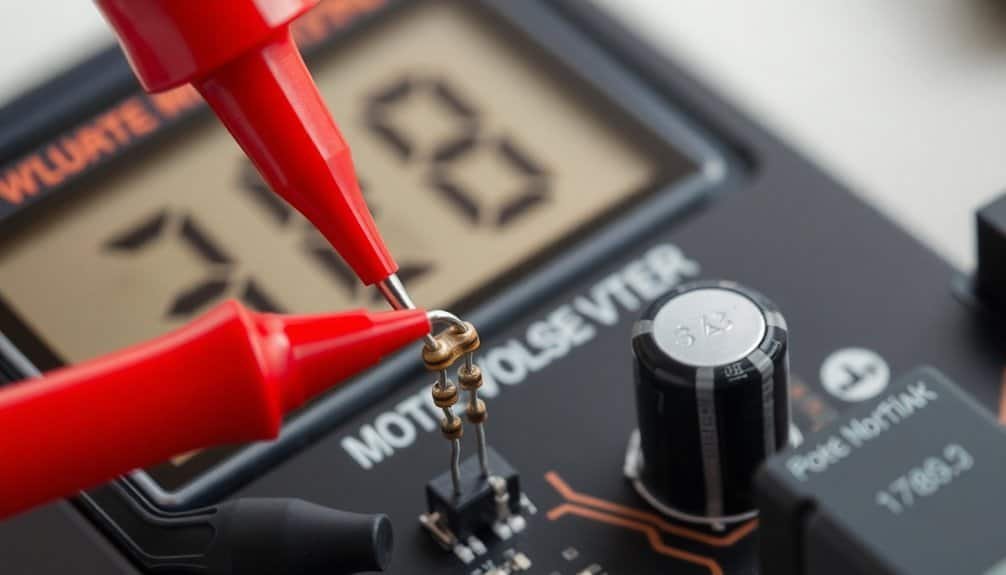
When operators lack proper training, it can lead to significant errors in measuring electromagnetic fields (EMF), affecting the integrity of data collected.
Here are three common operator errors:
- Inadequate Calibration: Not calibrating devices regularly can result in incorrect measurements, as calibration guarantees accuracy in EMF readings.
- Improper Use of Devices: Misusing devices or failing to follow manufacturer guidelines distorts readings, while using inappropriate devices can lead to inaccuracies.
- Inadequate Distance from Sources: Measuring too close to EMF sources affects accuracy. Maintaining appropriate distance is essential for reliable data collection.
Overlooking All Sources of EMF
Failing to recognize all potential sources of electromagnetic fields (EMF) can result in incomplete data and misguided assessments.
Power lines and electrical wiring emit EMF continuously, even in inactive states. Common home appliances, such as hair dryers and electric blankets, operate in low-frequency ranges and contribute to overall exposure.
Office equipment, including printers and computers, also generates EMF. Important sources, like MRI machines in hospitals and transformers, mustn’t be overlooked.
Finally, proximity to cell towers, urban infrastructure, and certain building materials can amplify EMF levels. By identifying all these sources, you guarantee a thorough assessment of EMF exposure.
Ignoring Interference From Nearby Devices
Ignoring interference from nearby devices can greatly impact the accuracy of electromagnetic field (EMF) measurements. To guarantee effective measurements, consider these factors:
- Proximity Effects: Devices too close together can generate significant interference.
- Frequency Overlap: Devices operating at similar frequencies increase interference risks.
- Sensitivity Variation: High-sensitivity devices may react strongly to nearby electromagnetic sources.
Take precautions, like increasing distances, using shielding materials, or managing frequencies, to reduce interference.
Understanding these elements is essential. They help maintain accurate readings and prevent equipment malfunction.
Addressing interference guarantees reliable data in your EMF measurements.
Misinterpretation of Measurement Data
Misinterpretation of measurement data is a common error that can occur even after accounting for interference from nearby devices.
Incorrectly selecting the device frequency range may lead to invalid readings, as high-frequency devices might miss low-frequency EMF sources. Uncalibrated equipment introduces systematic errors and neglecting calibration uncertainty can result in unreliable conclusions.
Additionally, ignoring time-varying field effects creates inaccurate assessments, as single-point measurements may not reflect average exposure. Movement or proximity distortions can alter values too.
Overrelying on inexpensive devices often obscures frequency-specific issues, resulting in larger uncertainties and potentially non-compliant results. Proper techniques are essential for accurate measurements.
Frequently Asked Questions
How Can I Tell if My Exposimeter Is Functioning Correctly?
To determine if your exposimeter’s functioning correctly, regularly check its calibration, inspect the sensor’s integrity, and compare readings with known standards. Also, verify it’s free from physical damage and interference during testing.
Are There Universal Protocols for EMF Measurements?
Around 30% of workplaces don’t follow specific EMF measurement protocols. While various guidelines exist, no universal protocols are established, as methods often vary depending on EMF frequency and application. So, always choose the right protocol.
What Materials Can Enhance EMF Shielding Effectiveness?
To enhance EMF shielding effectiveness, use materials like copper, aluminum, and specialized alloys such as mu-metal. Consider combining conductive polymers or composites for a lightweight solution that maintains durability while effectively reducing electromagnetic interference.
How Do I Identify Weak Points in My Shielding Setup?
Did you know nearly 30% of shielding setups have unsealed gaps? To identify weak points, regularly inspect for openings, use EMF meters to measure fields inside and outside, and guarantee materials are highly conductive and properly installed.
Can I Measure EMF in High-Traffic Areas Safely?
Yes, you can measure EMF in high-traffic areas safely, but make sure to follow safety regulations, use calibrated equipment, and document varying conditions. Always account for potential interferences from nearby electronic devices or transient sources.
Conclusion
Inaccurate EMF measurements often result from common mistakes, such as improper device placement and neglected instrument calibration. Considering environmental factors and thoroughly testing shielding effectiveness are crucial.
Training operators helps minimize errors, and identifying all EMF sources is fundamental. Nearby device interference can distort values, making accurate data interpretation essential.
Meticulousness and thoroughness in these areas can significantly enhance the quality of your EMF measurements.

